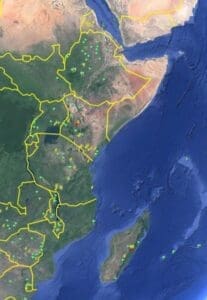
The Seventh international Conference on Vetiver – ICV7
VETIVER FOR SOIL & WATER CONSERVATION: In Commemoration of His Majesty King Bhumibol Adulyadej the Great
This long-delayed conference is now firmly scheduled from May 29 – June 1, 2023, in Chiang Mai, Thailand, and will be hosted and organized by the Office of the Royal Development Projects Board (ORDPB) of Thailand. The conference will be hybrid – in person and live online. Details are now being finalized and should be announced shortly on the ICV7 website at: The Seventh International Conference on Vetiver (ICV-7) — Look for the “Third Announcement”.
The conference website, when updated, will include: schedule, accomodation, and registration, awards programs (King of Thailand awards and TVNI awards), field trip, and pre-conference vetiver handicraft training course. We encourage the submission of papers and presentations, the best of which will be eligible for the aforementioned awards. Apart from scientific based papers I would hope to see some detailed presentations reflecting practical on site applications, together with cost/benefit data, and recommendations relating to user strategies and policy needs. The theme “Vetiver for Soil and Water Conservation” brings the focus back to how Vetiver Grass Technology can be used to improve our soils and the plants grown on them, whilst at the same time allows discussion on soil and water issues that challenge us in this fast-changing world of “Climate Change” that might be addressed by the Vetiver System.
Short Video Competition ($8,000 in prizes, and a special Award from TVNI’s Patron HRH Maha Chjakri Sirindhorn for the best overall video)
As announced in the August Newsletter deadline for video submission for this competition has been extended to October 31, 2022. Thus far there are 23 entries, and we expect a few more. There is still time to enter, you will find details here. Even if you don’t win a prize your video will not be wasted and will be shared throughout our network
Vetiver and Disaster Mitigation:
At this time of writing hurricanes/typhoons have been battering the Caribbean, Florida, Philippines and Vietnam. Our thoughts immediately turn to our vetiver friends in these countries, and we hope for their safety. These savage weather events are expected to be more severe in the future; vetiver provides a means to lessen the damage, and sometimes repair it as well. Our vetuiver social media platforms provide important opportunities to share your vetiver related hurricane events with others in our global network – how did vetiver stand up to major flooding, high velocity water events, submergence, and the protection of land and structures.

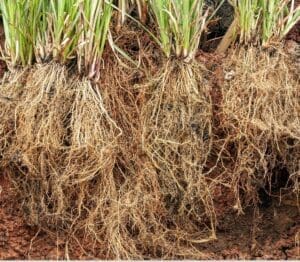
Warren Sullivan’s Mosquito Farm
Located on Trinity Bay Texas, has become a major source of Sunshine Vetiver in the US. Warren originally planted vetiver (along with other species) to protect his shoreline bank. Vetiver grows very well and has survived past waether events and storm surges, one 9 feet deep. Here are a couple of images from his shore-line bank. (Note, the massive root concentration that protects the land from washout).
Vetiver Panama
(Vetiver Panamá S.A. | Facebook) is owned and operated by Marietta Landis who also coordinates the
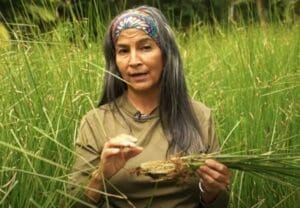
Panama Vetiver Network. Marietta has 2 ha of vetiver growing on her property and she supplies planting materials to buyers, as well as advising on VS applications in Panama. Marietta’s property (an ecological reserve in the Chiriqui area of Panama) was subjected to a major rainfall induced landslide in 2008. She repaired the affected area using Vetiver Grass Technology. She also uses vetiver to help prevent possible future landslides on other susceptible sites. She has posted a short video on YouTube part of which describes the regeneration of the landslide damaged site (in Spanish with English subtitles).
New vetiver related social media site:
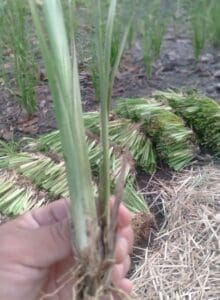
Vetiver Grass Buy and Sell Philippines: This is a new site with over 200 members. An excellent initiative by both small and larger businesses to market and scaleup VS applications in the Philippines. I am told that there are an increasing number of small growers who grow on average about 1,000m2 resulting in net revenues of about US$1,600/yr. They sell directly to end users or to larger companies that have large supply contracts with end site contractors – e.g., for highway stabilization. As can be seen from some of the images the quality of vetiver slips, and their presentation, look good and are prepared in a very acceptable way. Three tiller slips (bare root) sell from 2-5 US cents each, depending on quantities sold. These small nurseries can often expand as demand increases. Often the nursery is developed on unused land or in place of grass under coconut trees. I see that in Thailand vetiver is sold from 1-2 cents a slip including shipping. Under Thai and Philippine conditions, a million or more slips/ha can be achieved, that at these prices will result in a gross revenue of US$10,000 to 20,000 per ha. (Note, the average farm revenue for rice in Thailand is about US$800/ha, based on a national average of 3 tons/ha yield). Clearly there is a case for institutional policies to encourage use of vetiver for public infrastructure projects. Such policies would definitely benefit small and poor farmers as vetiver propagators and would provide employment opportunities for out of season farm labor. Jane Wegesa tells me that the market price of vetiver slips in Kenya is US cents 15 each. If demand can be significantly expanded prices would fall as more propagators set up businesses.

Related to vetiver propagation,
readers might be interested in the following extract from a 2016 presentation by E.V.S Prakasa Rao — Vetiver Systems for Carbon Sequestration and Economic Returns that contains the table in Photo 6.
The addition of dolomite significantly increased (nearly 3 times) the number of vetiver tillers and 3.5 times the plant biomass. Most tropical soils tend to be acidic dolomite might be a useful addition, particularly for those who are nursery propagating vetiver. If you are not already using lime it certainly might be worth testing.
Allelopathic effects of vetiver grass.
Lindokuhle Xolani Dlamini of South Africa posted a link to his interesting research paper: “Do native Grasses emerge and establish in areas rehabilitated using vetiver grass?” It raises some interesting observations and questions relating to vetiver’s interaction with adjacent plants, including its ability to support the germination of the latter, but also the suppressing of seedling growth. His paper had me look at some earlier vetiver archive papers on allelopathy — Allelopathic Effects of Vetiver Grass nn Weeds and Physico-chemical interpretation of allelopathic interaction of vetiver with two non-edible oil yielding fence plants. In the latter paper it was found that vetiver leachates promoted the growth of Jatropha sp. seedlings but inhibited Ricinus sp seedlings. In the past Mauritian tea planters used vetiver planted around tea gardens to prevent Kikuyu grass (Pennisetum clandestinum) from entering the gardens – was this due to the barrier effect of vetiver or to allelopathic effect? The Vietnam Vetiver Farmers Group have demonstrated improved (certainly not inhibited) growth of citrus, dragon fruit, black pepper, grapes and other plants when planted in close proximity to vetiver; as has also been demonstrated with tamarind in Thailand. Dave Riley, our Queenslander vetiver gardener, has not reported any allelopathic events. There are reports of reduced crop yields in the immediate row next to a vetiver hedge, but this is more than made up by increased yields in more distance rows due to soil moisture improvement, reduced nutrient losses from reduction in eroded soil, and further positive benefits from vetiver mulching if applied. There appears to be a host of complex interactions taking place that need to be identified through research.
Red Imported Fire Ant (RIFA)
Recently Feng Ziyuan of China, who is a major provider of Vetiver System services for bioengineering and phytoremedial applications purposes, wrote to ask whether vetiver could be used to control RIFA (Solenopsis invicta); RIFA has become a major problem in China. We found this recent paper “Herbal plants as alternatives for the management of the red imported fire ant, Solenopsis invicta”. Quotes from this Taiwan research abstract are below:
“In the quarantine zone of Taiwan, RIFA re-infestation frequently occurs despite the intensive application of synthetic pesticides, making its control costly and ineffective. Thus, there is an urgent need to identify eco-friendly and sustainable alternatives for controlling RIFA populations.
- Five herbal species, Tagetes lemmonii, Armoracia rusticana, Cymbopogon citratus, Cymbopogon nardus and Chrysopogon zizanioides, were grown in a RIFA-infested field with local weeds as controls.
- Generally, the field surveys showed more ants and intruded plants in the control than the herbal groups; however, the significance varied based on the trap type and plant species”
- The digging bioassays demonstrated that the above ground parts of lemmonii, C. nardus, C. citratus and the belowground parts of T. lemmonii, C. citratus and C. zizanioides effectively repelled RIFA.
- Herbal plants are eco-friendly, sustainable alternatives for controlling and preventing RIFA infestation in severe infested and non-infested areas.”
Another paper “Exposure-altered repellency of vetiver oil against red imported fire ant workers (Hymenoptera: Formicidae)” found that “In the choice bioassays, vetiver oil exhibited a significant repellent effect to workers without prior exposure, but the repellency of vetiver oil to previously exposed workers decreased at low concentrations “
In a US patent filing we find this abstract:
“Extracts of vetiver oil were found to be significant repellents and toxicants of ants, ticks, and cockroaches. Nootkatone (Ed … an important chemical in vetiver) was shown to significantly decrease ant invasion and increase mortality in fire ants. Nootkatone is an effective repellent and toxicant of ants either by itself or as an addition to other substrates, including mulches made from vetiver grass roots, diatomaceous earth, alumina, silica, clays; building materials made from either aluminum or wood; and other suitable solid substances. Nootkatone was also a repellent and toxicant to ticks and cockroaches. Nootkatone is non-toxic to humans and other mammals and is environmentally safe. In addition, it is believed that other extracts of vetiver oil, specifically α-cedrene, zizanol and bicyclovetivenol, will be effective against ants, ticks, and cockroaches.”
Jim Smyle recently wrote “From my own experience, I have Vetiver planted in 4 places on my land in Texas. We have the same fire ant issue there. In the almost 25 years that they have been planted there, I have never found a fire ant nest in or near the Vetiver”.

Landfill seep repair using vetiver grass.
Landfill seepage can be a serious problem. Leachate
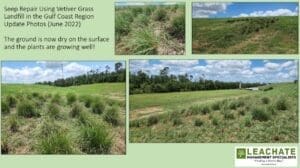
Management Services Inc (Field Manager – Eric Wiediger) shows how vetiver can repair a damaged landfill with seepage problems (See earlier post at Vetiver Grass for Landfill Leachate Seep Control. What looks like about 100 plants did the trick in drying out this wet spot. Paul Truong demonstrated the same many years ago on a seeping landfill in Australia, as did Xia Hanping for a huge landfill in south China. It is important to remember that vetiver also will very effectively dry up septic tank seeps and leaks – a very low-cost way of dealing with a problem that is common across the world. In many cases 20-40 vetiver plants will do the trick for a faulty family septic system. Much cheaper than a new system, and no more spills into the local drainage systems or beaches.
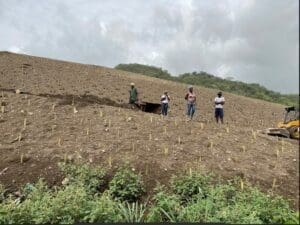
Landfill stabilization in Grenada.
Recently June Slinger sent me some photos of the vetiver application at the Perseverance landfill, that she planted to the design of the landfill consulting engineer. See below. My first reaction was that the plant population density is too low and that it would have been better to have planted in rows (erosion control). The current planting could result in a major erosion problem in the early years in the event of a major rainstorm event. Also, there would be an opportunity here to pump the leachate from the leachate ponds to irrigate the vetiver, and in that way dispose of the leachate through phyto-evaporation. Taking account of the allelopathic impact of vetiver on selective plants (as noted earlier in this newsletter) is it possible that planting vetiver in the current configuration at the site might, together with the shading impact of vetiver, be an effective method of natural weed control, and allow for better vetiver long term growth and survival? Opportunity for discussion here.
Vetiver ability to tolerate very high levels of nitrogen.
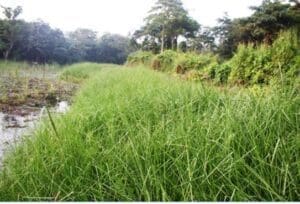

Pradeep Kumar of Biostarts Ventures of India sent me this article about the use of vetiver to stabilize and clean up explosives leachate pond and dump site at INDIAN EXPLOSIVES Pvt.Ltd. – ORICA, Gomia, Jharkhand, India. This site had very high nitrate, phosphate and lead levels as well as other heavy metals. Vetiver has the ability to deal with very high levels of nitrogen. Some years ago, Paul Truong rehabilitated an explosives dump site in Queensland, Australia that had the nitrogen levels set out in the Figure 1 below. Earlier Truong work showed that vetiver could tolerate 10 tons N /ha. This factor is borne out in the Biostarts application where rapid growth and high biomass yield of vetiver was equivalent to 80 tons green biomass/ha over 4 months (leaf height 1.5m and root length 1.0 m at 4 months).
News from Venezuela.
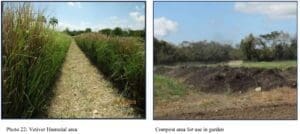
Oswaldo and Rafael Luque have over the past 30 years played a critical role in introducing the Vetiver System to their country and were instrumental in the convening of ICV4 in 2006 that was held in Caracas. Oswaldo recently shared with us “Applications of the Vetiver System, Technical Reference Manual, Biofilter Vetiver System“. This publication describes three cases where vetiver was effectively applied as the key technology to treat wastewater and sludges. These case studies are:
1. Pepsi-Cola discarded beverages – treatment of 2 million liters of high sugar content discarded soft drinks.
2. Bodegas Pomar (Winery) – Treatment of contaminated water from winery. Has been operating since 1993.
3. Alimentos Polar Chivacoa (APC) – Treatment of a factory waste disposal area.
Back to agriculture and conservation farming!
Vetiver for flood protection and windbreak for crops
Pablo Ruiz Lavalle from Oaxaca, Mexico posted a photo of vetiver hedgerows from the upper catchment of the Rio Grande close to the town of San Jerónimo Tlacochahuaya (average rainfall 34”/year). He writes
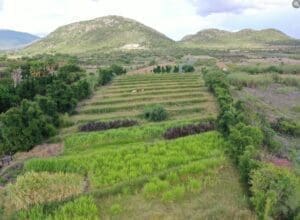
“this plot is located at 17.004493° -96.564254° next to a seasonal river which is the only water exit route of an 80 sq
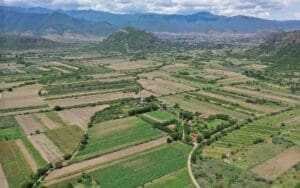
km watershed. Once every 10 years or so the river overflows, carrying away the soil of all plots along the banks. Vetiver was planted as the main component of a strategy for soil retention on such events. The hedges distribute and infiltrates water, but also they provide a much needed windbreak, since wind is the major factor for water evaporation here. I can’t give you hard data but irrigation requirements are lower than before vetiver was established for sure, meaning more water is available for forage grass for longer periods of time. Now we’re turning this area into a syntropic system (a form of regenerative agriculture) …will keep you posted!
We used to grow alfalfa on this plot, cut it, dry it and take it to the stable…lots of work. In the meantime we established Bambusa oldhami on the perimeter as windbreak, and the vetiver hedge. After 5 years alfalfa is gradually replaced by a local grass, so we decided to bring the cows to the paddock, keep them tight with electric fence, and rotate them frequently. It has worked well. Besides we grow king grass (Pennisetum purpureum), that we cut and use when we need to allow the grass to recuperate for a longer time, during the dry season. Cows also love the bamboo leaves. I know they would eat the vetiver if there were no more palatable options around, but they leave it alone as things stand by now”